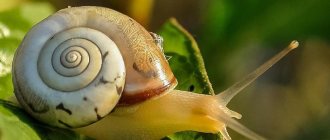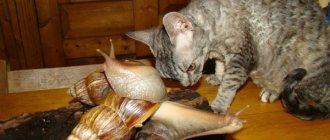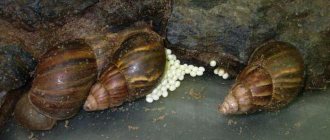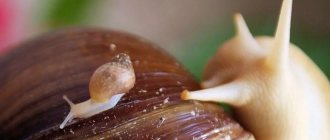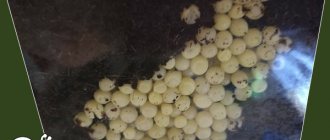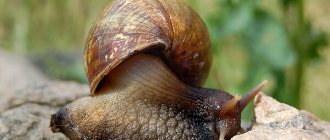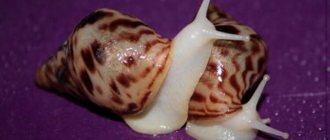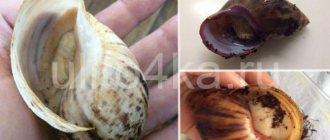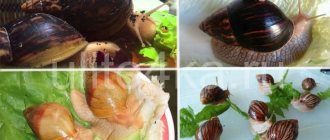The Achatina Tiger snail got its name for its spectacular tiger-like color. The shells of these mollusks have a rich orange or bright yellow color, and against this background there is a pattern of dark brown lines. And in character these snails resemble tigers. They look graceful, have a noble appearance, are unhurried, even seem lazy - they spend the entire daytime buried in the ground litter, and only at nightfall they come out to “hunt” for delicious fresh vegetables.
Achatina snail Tiger
The Achatina Tiger snail got its name for its spectacular tiger-like color. The shells of these mollusks have a rich orange or bright yellow color, and against this background there is a pattern of dark brown lines. And in character these snails resemble tigers. They look graceful, have a noble appearance, are unhurried, even seem lazy - they spend the entire daytime buried in the ground litter, and only at nightfall they come out to “hunt” for delicious fresh vegetables.
What to feed
Tigers are not particularly picky, the main thing is that the vegetables and fruits are fresh and of good quality. They happily eat:
- cucumbers,
- you can feed with zucchini,
- pumpkin,
- sweet potato,
- tomatoes,
- lettuce leaves.
From fruits you can offer your pet:
- pears,
- apples and sweet varieties,
- bananas.
It is interesting that each individual has its own preferences, so first you need to observe what your pet likes most. There are specimens that even eat boiled buckwheat with meat puree for baby food, and they also choose the type of meat they like. You can also feed it by grinding cereals.
In order for the mollusk to have enough calcium for constant shell growth, it needs additional feeding. Calcium is contained in shell rock, natural chalk, natural sepia (snails love to crunch on it), and special feed chalk is also sold. To make the tiger snail more actively consume calcium, chopped vegetables and fruits can be sprinkled with grated chalk and raw egg shells crushed into powder. But it is better to give less protein supplements.
Types of Achatina tiger
The color of the shells and body of the snail is varied. The background of the shell varies from light yellow to orange with broken and even stripes, thin and thick lines and blurs of black or brown.
Subspecies Achatina achatina
Achatina achatina Bayoli
In this subspecies, the yellow background occupies approximately 70% of the shell, and there are fewer brown lines than in other subspecies. The body is light, with a clear stripe on the neck.
Achatina achatina Roseolabiata
The main difference from the simple Achatina Achatina is the pink apex. The color of the body is lighter than the standard, with a tint of beige.
Achatina achatina Depravata
The shell is completely yellow, orange or red, without black stripes. Columella is blue or white.
Achatina achatina Elegans
Smaller, more elegant than other tigers. The shell is the same color as Achatina Achatina, the stripes are black, thin and even.
Achatina achatina Togensis
The shell is orange or dark yellow, the stripes are thin, zigzag, the columella is white or blue.
Achatina achatina Albino
The shell is yellow with brown stripes. Columella is white or yellow. Leg color is white. ABOUT
Achatina fulica (Achatina fulica)
Achatina fulica - Achatina fulica
Fulica lives in a tropical climate. The length of the mollusk is 20 cm. In a terrarium it grows up to 17 cm. The shape of the shell is conical with 6-9 turns. Body color is beige, light brown, less often black. The structure of the sole is coarse-mesh. Read more about housing and feeding here.
The color of the shell varies from dark brown to red. As the shell ages, it develops dark streaks and blurring. Apex brown, less often sandy, pointed. Columella is white or bluish in color.
Achatina Fulica umbilicata Neville
The snail does not require constant care and is inexpensive to maintain, which is why novice terrarium keepers choose it. The snail is omnivorous and gluttonous. Loves water, but does not tolerate waterlogging in the terrarium.
Active at temperatures from 20 to 28 degrees and humidity from 65% to 75%. In captivity, it lives up to 8 years. Achatina fulica becomes sexually mature at 5-6 months, with a clutch of 250 to 700 eggs. Egg size is 5-6 mm.
Achatina Fulica rodatzi Dunker
The fulika moves calmly and slowly. Watching her calms her down. In the first half of the day, she chooses a quiet place and takes a nap there. She is timid and makes a squeak when she hides in a shell. With poor care, it hibernates for up to 9 months.
In a community of relatives, compliant and friendly. The snails eat in turns, without interfering with each other. To keep 1 fulika, a terrarium volume of at least 15 liters is required.
Achatina Fulica sinistrosa Grateloup
Varieties of Achatina fulica:
- Achatina Fulica hamillei Petit
- Achatina Fulica rodatzi Dunker
- Achatina Fulica sinistrosa Grateloup
- Achatina Fulica umbilicata Neville
Achatina Fulica hamillei Petit
Reproduction method and lifespan
Tiger snails are hermaphrodites, that is, bisexual creatures. Each individual has female and male organs - cross-mating occurs. Sexual maturity occurs at 1.5-2 years, most often the offspring appear by the age of 3. But there are many cases where babies appeared already in the 1st year of a mollusk’s life.
The first clutch, as a rule, is small - from fifty to a hundred eggs. The next ones are up to 300 pieces. The eggs are about 8 mm long, have an oval shape, a diameter of 5-7 mm, the shell is white or slightly yellow. The incubation period is 15-24 days. The temperature in the terrarium at this time should be at least 24-25° C. Despite the rather large clutches, tiger snails do not hatch from all eggs.
Feeding newborn mollusks is similar to adults. There is no need to feed with proteins and carbohydrates; it is enough to give calcium. Active growth of cubs occurs in the first year of life and slows down at the end of puberty.
The lifespan of tiger Achatina in captivity is, on average, from five to seven years.
Feeding
photo can be enlarged
Neretins are the best destroyers of all kinds of algae. These active snails are constantly on the move, leaving a clean trail behind them. Mollusks do not harm aquarium plants, but they cannot get rid of all algae. Since algae appears as a result of an imbalance in the aquarium, this problem must be solved first.
In addition to their favorite foods, neretinas should be given cereal flakes and an algae called spirulina. While consuming food, the snail constantly crawls from place to place, and then can freeze for a long time. Do not panic ahead of time, thinking that your pet has died. You need to smell the neretina, because a dead snail has an unpleasant odor.
Possible difficulties
When breeding Achatina, you may encounter some problems, most often due to improper maintenance of the pet.
Temperature violation
The health of the snail is negatively affected by too high or low temperatures, as well as drafts. The risk of overheating occurs when the terrarium is located near heating devices or in direct sunlight. If there is severe overheating, the mollusk dies.
Temperatures below +19 °C inhibit the development of Achatina and even lead to suspended animation.
Signs of temperature exposure include loss of activity in the pet and refusal to eat.
In case of overheating, the snail must be held under running cool water, and in case of hypothermia, carefully wipe it with a soft, warm cloth.
Drought in the terrarium
Low humidity in the terrarium negatively affects the condition of the pet. Therefore, it is necessary to constantly maintain the humidity level in his house at 70% -85%. For this purpose, it is recommended to use a spray bottle and a hygrometer.
If you see a mollusk hiding in a shell, you should immediately check the humidity level in the terrarium.
Masonry period
As a rule, in the natural environment, Achatina pregnancy is not accompanied by complications, which cannot be said about snail reproduction at home. In captivity, the formation and gestation of clutches contribute to a number of problems:
- cessation of growth and development of an individual;
- significant consumption of protein and calcium;
- thinning of the shell with subsequent deformation and detachment.
Young small Achatina can hibernate during pregnancy.
To maintain the condition of a gestating snail, you must strictly adhere to all recommendations regarding climatic conditions in the terrarium and feeding regime.
Constantly in a dream
Hibernation is a common reaction of a snail to unsuitable living conditions, as well as poor-quality food or its absence. Suspended suspended animation that continues for more than 20 days significantly depletes Achatina’s body. If the mollusk is not brought out of this state in a timely manner, it may die.
During the pet's hibernation, it is necessary to monitor the condition of the protective membrane (epiphragm); if it is pulled inside the coil, it means that the individual begins to dry out and needs immediate awakening.
Snail shell problems
When breeding Achatina, problems often arise associated with the unsatisfactory condition of the shell; in most cases, they are caused by errors in its maintenance. These include:
- deficiency of calcium, protein and vitamins in the body;
- incorrectly selected soil: rocky or sandy;
- frequent bathing of the individual under running chlorinated water;
- the presence of a fungal infection as a result of unsanitary conditions;
- unsuitable climate conditions;
- insufficient volume of the terrarium.
If you find bite marks from other individuals on the shell of a mollusk, you must immediately isolate the affected pet and also include as much calcium in the diet as possible.
Clam shell care includes the following:
- keeping in mats or only high-quality soil;
- ensuring the required temperature and humidity level;
- use only purified and well-settled water for all your pet’s needs, including bathing;
- regular feeding with mixtures containing calcium;
- treatment of the coil with special compounds: propolis-based ointment, natural vegetable oils; products containing vitamins A and E;
- the constant presence of pumpkin and carrots in Achatina’s diet.
Cracks in the coil are repaired using glue, plaster or plaster.
A snail may not come out of its shell due to improper maintenance or stress. To force your pet to leave the shell, you need to bathe it in warm and clean water, and then put fresh food in the terrarium.
Bad heredity, the negative effects of pesticides and parasites can cause Achatina to fall out of the shell. In this case, the probability of death is 98%.
Young individuals still have a small chance to grow a new round; an older snail will certainly die.
Diseases
photo can be enlarged
All snail diseases occur from improper care and poor feeding. If you control the temperature, hardness and acidity of the water, then most deviations can be avoided, for example, shell flaking.
Cracks and chips in the shell can heal if the snail is provided with complete rest and the diet is filled with plenty of calcium. A white coating on the shell indicates the aging of the snail.
A plaque similar to mold can be caused by fungal infections; in this case, it is necessary to place the snail in a separate tank and take baths with salt or potassium permanganate. For prevention purposes, all new individuals must be placed in separate quarantine and monitored for health.
Giant Australian trumpeter
The largest specimens of gastropods known to science live in the tropical coastal waters of Australia, Indonesia and New Guinea. These are Syrinx aruanus, or Australian whelks.
Predatory gastropods are poorly studied due to their small numbers. Their beautiful peach-colored shells attracted the attention of the aborigines, as they made very unusual jewelry and hair clips. As a result of barbaric actions, the population of giant Australian trumpeters has been greatly reduced.
Average size of an adult Syrinx aruanus:
- Shell height – 55-60 cm;
- Diameter – 20-40 cm;
- Body weight – 13-15 kg.
The record-holder weighs 18 kg, the length of its spindle-shaped shell is 91 cm. In 1979, these data were recorded by a representative of the Guinness Book of Records.
The sea snail Syrinx aruanus lives in shallow waters in warm, sandy soil, where worms are abundant and form the bulk of their diet. Australian trumpeters live from 60 to 80 years, that is, their average life expectancy is approximately the same as that of a human.
Subspecies
Achatina Tiger has several subspecies. In Russia, they mainly keep the standard form Achatina achatina (typical Achatina). The albino species, Achatina achatina albino (Achatina Albino Tiger), is also in demand among lovers.
Achatina achatina are the largest tigers, they are recognized as the standard. These standard snails can be found in most snail breeders' collections. The length of the shells reaches 15-20 cm, their color background is orange or yellow-orange, the pattern is zigzag stripes of nut-brown color. The tip of the shell (apex) is colorless, the part of the shell to the right of the mouth (columella) has a pink-red tint, the inside of the mouth is white with a barely noticeable blue tint.
Achatina achatina albino - snails with a completely snow-white body, placed in a bright and amazingly beautiful yellow-black shell.
Those who are seriously interested in breeding and keeping snails also keep such subspecies as:
- Achatina achatina Bayoli - their shell color is almost 70% yellow, and there are fewer black stripes than other relatives. Stripes in the form of zigzags, sometimes instead of stripes there are spots or dots. The leg is light, there is a clear stripe on the neck. Snail breeders in the CIS and Europe rarely keep these mollusks.
- Achatina achatina Roseolabiata - differs from the typical Achatina Tigers in having a pink apex, the leg has a grayish tint, and there is a clear stripe on the neck.
- Achatina achatina Depravata - have uniform shells of yellow, brownish or red color without dark stripes. The apex is white or with a pinkish tint, and the columella is pink or crimson. The shell dimensions are up to 15 cm in length and up to 8.5 cm in diameter. In Russia and the CIS, this subspecies is kept extremely rarely.
- Achatina achatina var. monochromatica - have rounded yellowish-brown shells without a striped pattern; they are not found in Russia and the CIS.
- Achatina achatina Elegans - considered a dwarf form of the standard Tiger snail, shell length - 15 cm, diameter up to 8.5 cm. Coloring - the same as the standard ones. Experts believe that they should not be classified as a separate subspecies.
- Achatina achatina Leucistic - Achatina with incomplete albinism, that is, the pigment is only partially present. These snails have colored pupils.
Types of snails
There are many types of Achatina, they differ in size, color, and sometimes character. 2-3 species are popular, the rest are rare.
Photo with species name
Common Achatina or “tiger” (Achatina achatina) Achatina Fulica (Achatina fulica) Achatina Reticulata (Achatina immaculata) Achatina Albopicta (Achatina albopicta) Iradeli or Lemon Achatina (Achatina iredalei) Achatina Glutin osa "Buraya" (Achatina glutinosa ) Achatina zanzibarica Achatina Craveni Achatina Panthera Achatina Tincta Achatina Kemovaya Achatina sp. "Cream"
Where does it live in nature?
The African snail prefers high humidity and high temperatures. It can be found near various bodies of water, in forests, meadows and fields. The habitat of individuals is tropical countries; in regions where residents are engaged in the cultivation of sugar cane, populations of Achatina are especially numerous. This is due to the fact that this culture is a favorite delicacy of shellfish.
Achatina snail in the wild
Where does Achatina live?
The homeland of the large snail is tropical countries with a hot climate. These are Nigeria, Togo, Liberia, Sierra Leone. In these countries, it used to cause enormous damage to crops and native plants. But these days, the number of Achatina tigers has decreased significantly, due to the ruthless deforestation of tropical forests and the collection of snails by the local population for food.
In many regions of Africa, Achatina Achatina is still considered a valuable meat and the most affordable type of protein. And also the largest specimens are exported from Africa to restaurants and snail farms in Japan and Germany. Clam mucin is successfully used in medicine and cosmetology in many countries.
It is not uncommon to find Achatina Achatina in Europe as an unpretentious and exotic pet.
A huge specimen of the tiger snail was discovered in Sierra Leone in 1976; the shell size was 288 mm, the body was 385 mm long, and its weight was 900 grams.
How to set up a terrarium
The Achatina tiger snail is one of the most difficult land mollusks to keep. For proper development, they need stable temperature, humidity and soil of the same quality throughout their entire life period. That is, the conditions in which the mollusk was born should be similar until it grows up and later in life. If you suddenly change the conditions of detention, the snail may get sick, start gnawing on its shell, and suffer from a lack of appetite. It is very difficult to bring the Tiger back to normal.
- The temperature in the terrarium should be 25-30° C,
- humidity is not lower than 80%, ideally 95%, that is, the snail is comfortable in a greenhouse or bathhouse.
If the temperature is below comfortable, the mollusk will stop growing.
The terrarium should be plastic or glass, horizontal type. The volume per individual is 15-20 liters. Two adults will be fine in a 60-liter “house”. There you need to place a bath with water for bathing.
Peat or soil from a deciduous forest is taken as soil; you can fill the bottom with coconut substrate (which is not very desirable; soft litter is better) or line it with sphagnum. Ordinary forest moss and fallen leaves are suitable as additions. The height of the soil layer is 10-15 cm, it can be higher, since tiger Achatina likes to burrow - they spend the main part of their life this way, feeding on the substrate.
Tiger snails do not hibernate, sometimes simply taking pauses of inactivity from several days to 3 weeks. At this time, their appetite decreases. When the Tiger is sleepy, he should not be disturbed. But keeping them is more interesting than other species, because you can communicate with your pet almost all year round.
Note! The Achatina tiger snail does not tolerate being kept together with other types of mollusks.
What and how to keep Achatina Achatina
At home, the mollusk is kept in a terrarium, aquarium or plastic container, which should be 3-5 times larger than an adult snail. Tigers are large mollusks, so give preference to horizontal terrariums with a large bottom area. The volume of the container to contain it must be at least 25 liters.
Achatina Achatina feels great at a temperature of 26-29 degrees. If your pet is active at 26 degrees and eats well, then there is no need to increase the temperature in the terrarium, but if you notice that the snail is not eating well and sleeps more, feel free to increase the temperature a couple of degrees. An incandescent lamp or thermal cord will help you do this. How to keep small Achatina.
Don't forget about humidity either. The optimal humidity for keeping tigers is 85%. This type of Achatina loves it when it is humid and warm. And since such living conditions are liked not only by snails, but also by midges, bacteria and mold. Proper ventilation should be taken care of.
Ventilation in the terrarium
So that the air circulates and does not stagnate in the terrarium. You need to make 4-5 holes on one wall (the number of holes depends on the size of the container), closer to the lid. Then the same amount on the opposite wall, only near the ground. If you notice that the soil is drying out quickly, seal a few holes. You can find holes in the lid of the container on the Internet, but this is not correct, since there is no air circulation.
Soil for Achatina tiger
At the bottom of the terrarium, place peat or coconut substrate with a layer of dried leaves or moss, etc. The soil should be about 1/3 of the aquarium. They burrow and sleep in it during the day; the soil also helps maintain the necessary humidity, but do not allow dirt and waterlogging. Spray it and the walls of the terrarium no more than 1-2 times a day. Review article on choosing soil for a snail.
Tigers are sensitive to the ground, do not replace it completely, they may refuse to descend on it. Always add fresh soil gradually.
Coconut substrate , a common and convenient type of soil. It holds moisture well and does not stain the walls of the terrarium. Snails love to burrow into it and rest after a hearty lunch.
Moss is considered a must if you keep Achatina Achatina. Sphagnum and forest moss retain moisture well and, with proper care, do not require frequent replacement.
High-moor peat or clean soil is also often used as soil. Just make sure that the soil does not contain fertilizers and pesticides.
Prohibited soils
Sand scratches the snail shell and the walls of the terrarium, clogs the digestive tract of the mollusk, and sand does not hold moisture well and clumps into clumps.
The sawdust scratches the snail's body, leaving small splinters in it that become inflamed and fester. Also, sawdust does not retain moisture, quickly acidifies and can cause a white coating on the shell of a mollusk.
Stones are not used, as they do not retain moisture, scratch the shell and body of the Achatina, and if it falls from the lid of the terrarium, the snail can break and die.
Achatina Achatina gets used to certain conditions of detention and reacts negatively even to small changes. Therefore, introduce innovations gradually so that your pets do not become stressed by refusing food until they hibernate.
Equip the tiger terrarium with driftwood, a shelter house and a container of water.
Mollusks often burrow into the ground under driftwood to rest during the day. For this purpose, you can place halves of a coconut shell or shards of a flower pot in the terrarium, which will serve as an interesting decoration and shelter for the tiger snail.
Achatina vulgaris naturally lives in hot and humid climates, so to artificially increase the humidity in the terrarium, place a container of water or a small swimming pool. The snail loves to “soak” its tail in warm water after a full meal.
Reproduction
Achatina are hermaphrodites, so they are not divided into females and males. For breeding them, two adult individuals will be quite enough. Fertilization in Achatina is always internal.
Pairing
It is recommended to mate a snail only when it has already stopped growing. Achatinas become sexually mature at 3-4 months, but they are not yet capable of laying eggs at this age. In this case, they usually die or hibernate.
Mating should not occur between individuals of the same clutch.
The genital organs of mollusks are located on the right side of the neck. The mating process involves rubbing two individuals with these body parts. Even one sexual intercourse is quite enough for fertilization, after which the snail can store the seed for up to 2 years.
How to understand that the Achatina snail is pregnant
The clutch of eggs is visible through the spiracle from the side already 7 days after mating. The egg-bearing mollusk loses activity and spends most of its time buried in the ground.
Achatina eggs in the ground and small snails
How Achatina lays eggs
If mating involves individuals of the same size, then fertilization should be expected on both sides. If one of the snails is larger in size, then this process will be one-sided. After mating, the snail is able to lay eggs monthly.
Some species of Achatina are viviparous and reproduce, immediately giving birth to small offspring.
Control of egg laying
The first clutch of a mollusk may be small, but each time the number of eggs will increase. Do not touch the masonry with your hands, as this will lead to the death of the mollusks. It is only permissible to collect eggs scattered on the ground with a spoon. If their quantity turns out to be more than expected, then the excess is destroyed. To ripen the masonry, it is necessary to ensure the soil temperature is from + 26 to + 28 ° C.
Achatina eggs
The eggs of the mollusk are oval in shape and white in color. They are surrounded on all sides by a layer of calcium.
Not all of the laid eggs of Achatina will be viable.
How long does it take for snails to hatch?
Under properly created conditions, small Achatina hatch from eggs in 12-14 days.
Achatina snails children and parents
How to care for little ones
The offspring that are born should be moved into a small container (8-10 liters) with holes made in it for ventilation. The optimal temperature in their house should range from +25 to 27°C, while the humidity should be 65-70%. It is recommended to use cabbage or lettuce leaves as soil for newborns. The diet of children should include ground vegetables, grain mixtures and calcium mixtures, as well as chopped greens.
Achatina snail growth chart
| Type/Size in cm | 1 month | 2 months | 3 months | 4 months | 5 months | 12 months |
| Akhatina Akhatina | 1-2 cm | 2-3 cm | 3-4 cm | 1-2 cm | 5-6 cm | up to 25 cm |
| Akhatina Fulika | 1.5-2 cm | 4 cm | 5-6 cm | 8-10 cm | 10+ | 10-18 cm |
| Achatina Immaculata | 2 cm | 3-4 cm | 5-6 cm | 7-8 cm | 10+ | 10-15 cm |
| Achatina Reticulata | 3-4 cm | 7+ | 10+ | 13-14 cm | 15+ | up to 20 cm |
| Achatina Panther | 2+ | 4+ | 6+ | 10+ | up to 12 cm |
The average length for the shell is indicated. Don't worry if your pet's measurements don't match the chart. Each snail has its own growth rate, depending on many factors. Most snails stop growing after the first year of life.
Historical data
The homeland of these giant mollusks is the eastern part of Africa with high temperatures and high humidity. Later, Achatina appeared in the Seychelles, Madagascar, Sri Lanka and India. Within 10 years, individuals spread to the territories of Malaysia and Indochina.
Having settled on the island of Taiwan, Achatina began to multiply rapidly, thereby creating a problem for local residents. The Taiwanese tried to find a way to get rid of snails, but at the same time they enjoyed eating their meat. And after the Japanese appeared in the south of the island, they began to prepare signature dishes from pests.
Japanese farmers began to artificially breed Achatina in order to sell their meat, for which a lot of money could be earned in Japan. Giant clams were unable to take root in the northern regions of this country due to unsuitable conditions, so Japan avoided their widespread distribution.
In Africa they eat Achatina snails
In India, Achatina eat the lion's share of the crop, and therefore the Ministry of Agriculture announced a fight against them. At the same time, clam soup is popular in this country and is used as a remedy for tuberculosis.
US laws prohibit the import of giant snails into its territory. Violators face a fine of $5,000 or up to 5 years in prison.
Habitat
The homeland of these land mollusks is the coast of East Africa, where the climate is humid and hot. They are found:
- in southern Ethiopia and Somalia,
- in Tanzania,
- Kenya
- in northern Mozambique.
In the west of the mainland - in Ghana, Liberia and Nigeria. At the end of the 19th century, these snails were smuggled to India and the island of Mauritius. At the beginning of the 20th century, they ended up in Asia in Sri Lanka and Thailand in the same way, and in the second half of the last century they ended up in New Guinea, Britain, Ireland and Tahiti.
Description of Achatina Tigers
The Achatina Tiger snail differs from typical representatives of the species. Their lifestyle and habits distinguish them as a transitional evolutionary link between the archi and Achatina. The Tiger's shell always has a pointed top, and its crocodile-like tail and body with pimply skin give it a resemblance to representatives of the arches.
Tiger shells reach 25 cm in length and 10 cm in diameter. The texture of the shell is smooth, there are 7-8 turns on the shell. Colors - different shades of yellow, monochromatic, with interrupted or continuous stripes in the form of zigzags, spots or dots of black or brown.
The apex can be colorless, sandy or dark beige, with wavy center lines. There are subspecies with a deep crimson apex (for example, Achatina Roseolabiata). Columella is only crimson in color.
In standard Achatina, the head and body can be of various shades of beige, and even almost black, while the head is darker than the legs. The leg has a dense structure.
Tigers grow slower than other members of their family. But constantly (until the end of life) and evenly, increasing both in length and in diameter. By the age of 1 year, the length of this mollusk should approach 12 cm - they grow, on average, a centimeter every month.
Achatina reticulata
Achatina reticulata - Achatina reticulata
Also a popular species among snail breeders. She is originally from Zanzibar. The length of the corrugated shell is 18 cm. The color of the shell ranges from light beige to brown with dots and axial stripes. The apex is beige or sandy, the collumella is white. The body and head of the reticulum are beige or brown, and the edges of the sole are light. Read more about care and reproduction in our article.
See more similar articles:
The snail is active, sociable and curious. Always cranes his head to keep abreast of events. She is smart, learns quickly, and you can easily teach her to eat by the hour. Gluttonous, eats everything.
Achatina reticulata dark
Active even in the first half of the day, becomes attached to the owner and distinguishes him from strangers. Favorable temperature for life is from 25 to 27 degrees and humidity from 60% to 75%. In captivity, it lives up to 6 years. At 10-12 months the snail becomes sexually mature; the clutch contains 300 eggs, 7-8 mm each.
Albino snails are valued among snail breeders. This variety of reticulata albino is smaller in size and grows slower than its counterparts. Their length is 15 cm. The color of the body and head is white. The color of the shell, apex and columella is milky white. Mobile, active mollusks easily come into contact with humans.
Achatina reticulata albino
To keep Achatina reticulata you need a terrarium with a volume of 20 liters.
Varieties of Achatina reticulata:
- Achatina reticulata light
- Achatina reticulata dark
- Achatina reticulata albino
Brown-headed Achatina reticulata - Achatina reticulata light
What are the benefits of snails for humans?
The secretion secreted by Achatina has a lot of useful qualities. Its effect on the human dermis is used to treat certain diseases.
How is Achatina used in cosmetology?
Achatina are the only species of giant mollusks that are used in cosmetology. Using their secret, the following procedures are performed:
- skin rejuvenation;
- removal of scars;
- reducing the number of wrinkles;
- getting rid of skin diseases;
- regeneration and moisturizing of the skin;
- lightening pigmentation.
The mucus secreted by the snail helps fight peeling, various inflammations and acne.
Snail mucin (in creams, serums, gels, masks); effect on skin
The secret of Achatina is included in many cosmetic products. This active use is determined by its unique components:
- collagen – maintains skin firmness and its natural elasticity;
- allantoin – promotes the regeneration process;
- elastin – maintains the smoothness of the dermis;
- peptides – protect against harmful bacteria;
- vitamins A, B, E, C;
- glycolic acid – removes impurities and dead cells;
- lectins – act as a cleansing agent.
Mucin has a positive effect not only on the surface of the skin, but also on its deeper layers.
Achatina massage
With the help of snail massage, skin elasticity is restored and lymph flow is stimulated. The wave-like movements produced by the mollusks help improve blood flow. The duration of such a procedure is up to 30 minutes.
Cosmetological facial massage with Achatina snails
Achatina Achatina in cooking
Snails have been eaten since time immemorial. The ancient Greeks and Egyptians highly valued snail meat for its nutritional value and taste. During World War II, snail meat was used as food for Japanese and American soldiers. Therefore, after the end of the war, the Japanese began to grow shellfish on special snail farms. Their meat was very popular in the post-war period. Without losing its gastronomic value even today.
In Africa and some cities in Brazil, the Achatina tiger is used for religious purposes, as an expensive offering to the great deity Oxala. In Sierra Leone and other African cities, Achatina is revered not only as an expensive offering to the gods, but also as easily accessible food. All inhabitants of Africa consume land molluscs as food.
How do Achatina differ from Arhachatina?
In addition to the popular giant snail Achatina, another representative of Africa, Achatina, is quite common among lovers of domestic mollusks. These two species differ in character, appearance and food preferences. The main differences include:
- Apex (end of the shell). In Achatina it is sharp, in Archatina it is rounded.
- Tip of the leg. In Achatina, the end of the leg ends in the form of the letter V; Achatina lacks such a feature.
- Body structure. The skin of Achatina’s legs is smooth and soft, divided into relatively large areas. The limb of the arhahatina is hard to the touch, divided into many small, rough protruding sectors.
- Behavior. Achatina is active, mobile and curious. Arhahatines are careful and slow.
- Reproduction. Mollusks differ in the size of eggs, the number of eggs in a clutch, and the age at which sexual maturity is reached.
It is not recommended to keep Achatina and Archatina in the same terrarium due to their different activities, requirements for climatic conditions and diet.
Rules of circulation
Proper handling of your pet, regular monitoring of the condition of the terrarium and compliance with all feeding rules will protect it from many diseases.
Giant African snail on hand
Should I pick up my pet?
It is permissible to pick up Achatina, but you must follow a number of rules:
- this must be done with great care so as not to damage the fragile shell and delicate mucus of the mollusk;
- hands should be perfectly clean, free of various bacteria, traces of sweat, residues of cream, detergents, salty and spicy foods.
Before removing the snail from the container, you need to remove pets from the premises: cats, dogs.
It is advisable that when handling Achatina, your hands are wet, which will greatly facilitate the gliding of the individual.
Bathing – necessary or misleading
Gastropods love daily water treatments, so it is recommended to equip a shallow pool in the terrarium in the form of a bowl of water. In addition, the snail needs to shower regularly. For this purpose, the individual should be picked up and held over a sink under a weak stream of warm water. This procedure should not last more than 3 minutes.
Bathing the Achatina snail at home in tap water
Achatina snail in hibernation
There are several reasons that trigger a mollusk to go into hibernation:
- severe stress, including due to sudden temperature changes;
- poor nutrition, lack of necessary supplements;
- low temperature and dry air in the terrarium;
- period of adaptation to new conditions.
Typically, hibernation in Achatina is observed in winter, when heat emanates from radiators in rooms, drying out the air. Before hibernating, the mollusk seals the mouth with a kind of film (epiphragm), formed from the produced protein elements, mucus and lime.
At the first signs that the snail is about to go into hibernation, it is necessary to increase water procedures more frequently, add calcium to the diet, and strictly control the humidity level in the house.
In a state of hibernation, the mollusk’s body is not replenished with water, which leads to a decrease in its body. Hibernation for more than 60 days can lead to the death of an individual.
How to wake a snail from hibernation
You can bring a mollusk out of hibernation by performing several actions with it:
- hold under warm running water for several minutes;
- wait for the moment when it looks out from the mouth, breaking the valve;
- place in a terrarium with optimal temperature and humidity levels;
- sprinkle with water.
You can also bathe Achatina in milk, chamomile water or whey. The temperature of any of these liquids should be +36°C. It is recommended to repeat the procedure if the snail does not leave the shell after the first time. However, many breeders question the effectiveness of this technique.
The shell of the Achatina snail as an indicator of health and what to do if it breaks
The health of a mollusk and the comfort of its living can be judged by the condition of its shell. If damage appears on the shell or its integrity is compromised, you need to use epoxy glue. In this case, Achatina needs to be provided with a diet high in calcium, adding special mineral supplements.
Problems with the snail shell: cracks, chips, scratches.
A shattered snail shell indicates its imminent death, so shellfish must be handled with the utmost care.
Feeding the Achatina snail with vegetables
Advantages and disadvantages of snails as pets
Achatina also has obvious advantages in keeping
Achatina is an ideal option for those people who are not able to pay much attention to their pet, but at the same time want to have some kind of animal. Of course, shellfish won't be able to provide the same returns as cats or dogs, but snails have their merits. So, let's look at all the pros and cons of keeping a snail in the house.
Pros:
- Achatina is unpretentious. You can go on a business trip for several days without worrying about the snail dying. In general, shellfish can go without food for several weeks. At this time, they hide in a shell and fall into suspended animation. But it’s better not to risk your pet’s life.
- Achatina does not make sounds, so you don’t have to worry about your sleep.
- Shellfish are suitable for allergy sufferers.
- There is little pollution from Achatina. All you have to do is clean the terrarium.
- Achatina is completely unpretentious in food.
If you follow simple measures for keeping your snail at home, your pet will delight you for several years.
Minuses:
- Snails reproduce very quickly. If you do not want to get offspring, the clutch of eggs will need to be regularly removed from the terrarium.
- Achatina are very voracious. This also affects the amount of feces.
- If hygiene standards are not observed, midges and microbes may appear inside the terrarium.
- It is necessary to clean your pet's home frequently to ensure that the snail lives comfortably.
- If you keep two Achatina, at night you can hear unpleasant creaking sounds coming from the friction of the shells.
Does the Achatina snail harm humans?
Achatina are considered harmless mollusks and do not create problems for humans living at home. However, it often happens that snails become infected with fungal diseases and parasites, after which they become carriers of them. For pets, such problems do not always pose a serious danger, but a person infected with them can die. This is especially true for worms that immediately penetrate the brain of people after entering their body, for example:
- nematode;
- fluke.
To prevent such situations, it is necessary to immediately take measures to combat parasites at the first suspicion of their presence in a mollusk.
average price
Neretina are sold in special stores that sell marine life. The price for 1 copy is set at about 110 rubles. You can buy snails at a lower price from hobbyists who exchange shellfish and offer their services on various websites. Such a product is also available at “bird markets,” but when purchasing, you need to carefully examine the appearance, observe the behavior, and you should not choose individuals lying on the bottom. There are cases when beginners bought empty shells. If you're lucky, some hobbyists simply give away the shellfish to reduce the number of inhabitants in the aquarium.
